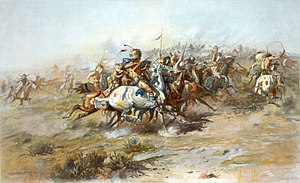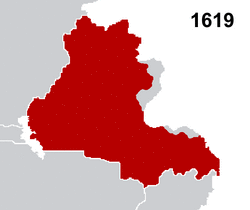Yellow Tree War
This article is incomplete because it is pending further input from participants, or it is a work-in-progress by one author. Please comment on this article's talk page to share your input, comments and questions. Note: To contribute to this article, you may need to seek help from the author(s) of this page. |
| Yellow Tree War | |||||||
|---|---|---|---|---|---|---|---|
| Part of the Western Expedition in Chistovodia | |||||||
 Batiska Brigade, a painting depicting Batiska horse archers in battle | |||||||
| |||||||
| Belligerents | |||||||
|
Batiskas Olotubils |
File:Flag of Soraviana (1612-1861).png Soravian Empire Chistovodia | ||||||
| Commanders and leaders | |||||||
|
Yellow Tree Yahto Artem Koslov |
File:Flag of Soraviana (1612-1861).png Louis II File:Flag of Soraviana (1612-1861).png Sava Ruban Vadym Mazur | ||||||
| Strength | |||||||
| ~150,000–350,000 warriors |
9,000 (1620) 74,000 (1640) | ||||||
| Casualties and losses | |||||||
| 80,000–100,000 total | 4,500 total | ||||||
The Yellow Tree War (Soravian: Війна з жовтим деревом; Viyna z zhovtym derevom) is the name given to the prolonged state of conflict that existed between the Soravian Empire through its Colony of Chistovodia and the Batiska peoples of the region. The war lasted over 25 years and saw the involvement of an estimated 400,000 personnel over the time period, including an estimated 300,000 natives, making it one of the largest native Asterian wars in history. The conclusion of the war saw Chistovodia annex much of the native Batiska land and the establishment of native reserves in the west of the country. Sponsored by Louis II, mass conversion programs began during the war and for a time after to convert the Batiska to the Episemialist Church. Overall, the war claimed the lives of around 85,000 people, over 90% of which were native, killed either by diseases in POW camps or in battle.
The war began after large periods of economic growth encouraged the mass migration of peoples to the coastal settlements of Chistovodia. Having gained a sizable monopoly over the exports of fur in the early 1600s, Chistovodia was one of the Asterias' richest and fastest growing colonies. The massive growth necessitated the need for westward expansion after cities could not expand quick enough to provide for the new population influx. Soraviana chose to expand west into unclaimed territory, previously known to have been inhabited by natives and left alone in a co-existence policy that saw Chistovodia's early settlements restricted to the coast. Spurred on largely by Sava Ruban, an advisor to the Emperor, Soraviana began its westward expansion in 1619. Meeting fierce initial resistance with the natives due to their extensive knowledge of the land, Soraviana made few gains until 1625, where a successful expedition confined the natives between to the western half of Chistovodia.
The creation of the Olotubils, groups of administrators and soldiers who defected to the native cause after initial protest over Chistovodian expansion further slowed Soraviana's progress, with the looting of camps and weapon theft common among the Olotubils to bring guns, ammunition and other supplies to the native resistance. One native, Yellow Tree, presumed leader of the Batiska tribe was renowned by Soraviana's forces for his combat prowess, often carrying a stolen rifle dressed in native garments, riding a horse along with it, eventually gaining enough notoriety and prestige to become the namesake of the conflict. The introduction of modern weaponry to the natives made it more difficult for Soraviana to advance, culminating in several native massacres that have seen the war labelled as a genocide by some. Resistance continued until 1645, when Yellow Tree was reported killed. Yellow Tree's death marked a turning point in the near-25 year conflict, with resistance unraveling from then on. Native forces were pushed back and eventually encircled at Lake Manatowick and decisively defeated at the Battle of Tapachanga in 1646.
After the war, settler colonialism began taking hold in Chistovodia, with native populations gradually decreasing as Soravian settlements and settlers began spreading across the colony. The creation of native reserves in 1648 also worsened the conditions of the natives in the area, confining them to small, policed areas and enforcing linguistic, cultural and religious suppression and conversion on their populations. To date, historians debate on whether the Yellow Tree War should be considered a genocide or not, with modern-day Chistovodia arguing the former.
